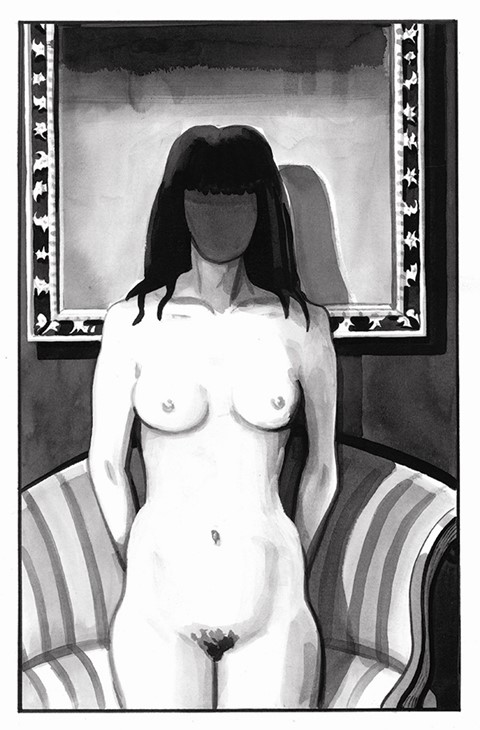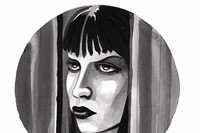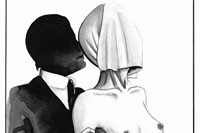This month marks the release of a new publication inspired by the infamous literary quarterly of the fin de siècle, The Yellow Book. Entitled The Purple Book – owing to the colour's links with sensory headiness, mystery and mortality...
This month marks the release of a new publication inspired by the infamous literary quarterly of the fin de siècle, The Yellow Book. Entitled The Purple Book – owing to the colour's links with sensory headiness, mystery, faith and mortality – the work is a fantastical homage to the Symbolist and Surrealist movements, as well as a celebration of the contemporary artists and illustrators they have influenced.
After compiling a number of tales by famously sensual and illusory storytellers, including Edgar Allen Poe, James Joyce and Christina Rossetti, the book's editors then approached contemporary artists, with a complementary penchant for the dream-like and decadent, to create illustrations for each text. The result is a sumptuously epicurean exploration of human imagination and desire, and of the combined power of illustration and the written word as a means of representing the dream-state. Here, to celebrate the release, we speak to renowned illustrator Andrzej Klimowski (whose striking monochrome depictions illustrate Szamota's Mistress by Polish horror writer Stefan Grabiński) about his involvement with the project and dalliances in the decadent...
How did you get involved in the Purple Book project? And what drew you to it in particular?
Angus Hyland, the book’s designer and co-editor approached me with the proposal of contributing to the project. Much of my work is equated with a dark, imaginative climate, its subject matter is often erotic and oneric. This fitted The Purple Book.
What interests you about Szamota’s Mistress as a story? Did you feel the style of writing was well matched to your style of illustration?
Szamota’s Mistress is a typical Stefan Grabinski story, on the edge of consciousness and dream. Like many of the Symbolist or Surrealist writers he takes his readers over a threshold, from familiarity into uncertainty. The central character is a vamp-like woman who entices a young man to her secluded villa. There she seduces him, subjugating him to a sequence of unnerving rituals. Her mesmeric hold over him becomes unbearable and on further meetings he begins to question her very existence. Grabinski’s writing is visionary and I am taken by forceful images, ones that verge on the melodramatic.
How did you choose which parts of the story to depict?
As I read a story, I scribble in the margins of the book or manuscript. I find that initial, spontaneous reactions are usually the most perceptive. I then study these doodles and try to arrange an appropriate rhythm to the images, creating illustrations that generate a mood specific to the story, at the same time trying to avoid too much detail. The readers have to have their own space in which their imaginations are activated.
"Much of my work is equated with a dark, imaginative climate, its subject matter is often erotic and oneric – this fitted The Purple Book"
Which writers/artists from the Symbolist, Decadent or Surrealist movements have most influenced your work?
When I was still at school I received a book prize for art. It was a large volume containing the complete works of Oscar Wilde. His short stories, plays and poems permanently affected my imagination. I could recite his poem The Sphinx by heart. It describes a twilight world in which a man’s fascination for a sphinx-like woman turns into a nightmare of subservience and enslavement. Then there are other symbolist writers; Georges Rodenbach for example, and the graphic artist Alfred Kubin who wrote one novel, Die andere Seite (On the Other Side). And painters such as Leon Spilliaert, Vilhelm Hammershoi, and De Chirico.
Do you have a favourite medium to work in?
I have several working methodologies. They vary according to subject matter that I am addressing. When designing posters or bookcovers I often work with collage or photomontage for its impact. On other occasions I will prefer working with brush and ink, gouache or linocut. I like working in black and white, when details vanish into the shadows and the imagination has to complete the pictures.
What inspires you?
People and places.
What advice would you give to young artists?
Once you know that art is your passion and your profession, stick to it, persevere. You may have to do other jobs to survive, but never give up your own work even if it is destined for the drawer or the plan chest. Sooner or later it will emerge. Unlike a sportsman or woman you should improve with age. The more you experience life, the more you have to comment about.
The Purple Book is published by Laurence King and is available now. An exhibition of Andrzej Klimowski's posters opens at Kawiarnia Relaks, Warsaw tomorrow.
Text by Daisy Woodward



